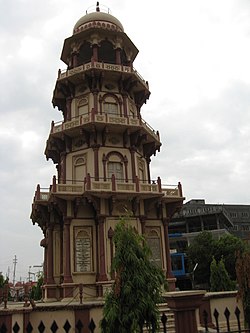Palanpur
|
Palanpur પાલનપુર |
|
|---|---|
| city | |

Kirti Stambh, a tower commemorating the history of the town and its former ruling dynasty
|
|
| Location in Gujarat, India | |
| Coordinates: 24°10′N 72°26′E / 24.17°N 72.43°ECoordinates: 24°10′N 72°26′E / 24.17°N 72.43°E | |
| Country |
|
| State | Gujarat |
| District | Banaskantha |
| Elevation | 209 m (686 ft) |
| Population (2011) | |
| • Total | 140,344 |
| Languages | |
| • Official | Gujarati, Hindi |
| Time zone | IST (UTC+5:30) |
| PIN | 385 001 |
| Telephone code | 91-2742 |
| Vehicle registration | GJ-8 |
| Population Growth of Palanpur | |||
|---|---|---|---|
| Census | Pop. | %± | |
| 1941 | 20,300 |
—
|
|
| 1951 | 22,600 | 11.3% | |
| 1961 | 29,100 | 28.8% | |
| 1981 | 61,300 |
—
|
|
| 1991 | 90,300 | 47.3% | |
| 2001 | 122,300 | 35.4% | |
| 2011 | 141,592 | 15.8% | |
| source: | |||
Palanpur is a city and a municipality of Banaskantha district in the Indian state of Gujarat. Palanpur is the largest city and the administrative headquarters of the district.
Palanpur in early times is said to have been called Pralhadan Patan, and to have been founded by Pralhadan Dev, brother of Dharavarsh Parmar of Paramara dynasty of Chandravati; it is said to have been desolate two centuries before the beginning of the Samvat era (57 B.C.). It was afterwards re-peopled by Palansi Chauhan from whom it took its modern name. Others say that it was founded by Pal Parmar whose brother Jagdev founded nearby Jagana village.
The history of Palanpur starts with its mention in its relation to historic city of Chandravati ruled by Paramara dynasty. The town was re-peopled ruled by Chauhans around thirteenth century. At the start of the seventeenth century, the Palanpur State was taken over by Jhalori dynasty of Pashtun Lohani tribe which was founded in 1373 and ruled from Jhalor. The dynasty came into historical prominence during the period of instability that followed the demise of Mughal Emperor Aurangzeb in the early 18th century. It was overrun soon afterwards by the Marathas; the Lohanis followed the trend of seeking recourse in the British East India Company against them and finally entered the subsidiary alliance system in 1817, along with all other neighbouring states, becoming a British protectorate. After independence of India in 1947, Palanpur State was dissolved in 1949 and merged with Union of India as a part of Bombay State. Subsequently Palanpur became the capital of Banaskantha district of Gujarat.
...
Wikipedia

